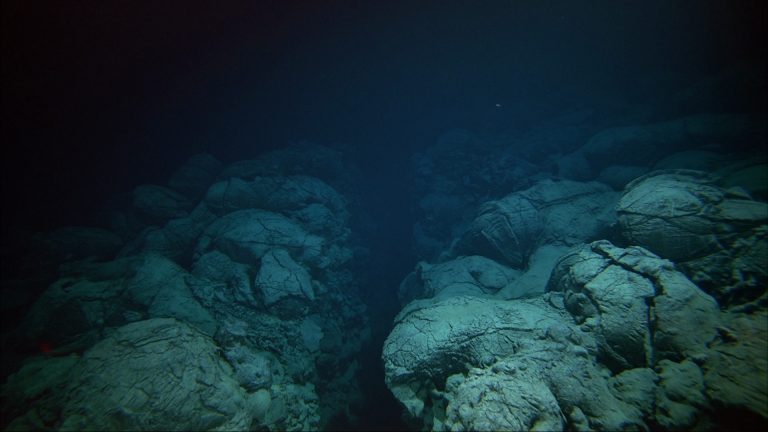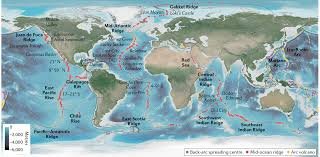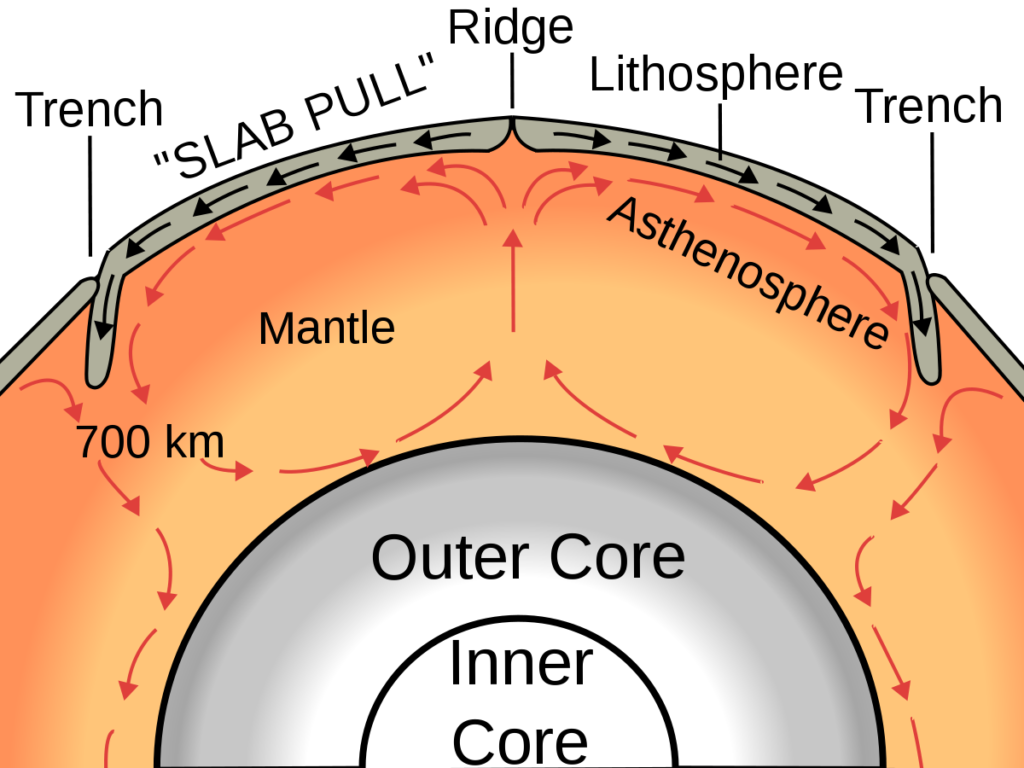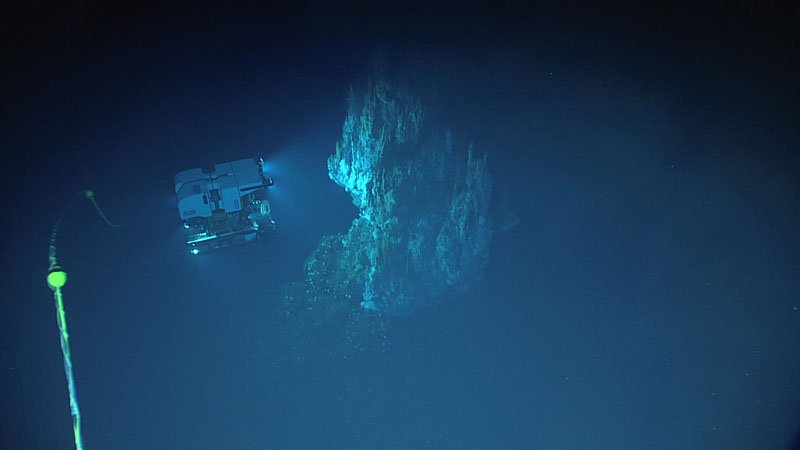Introduction:
Deep beneath the churning waves, a hidden world of fiery creation shapes our planet. The mid-ocean ridge, a gargantuan underwater mountain chain, stretches around the globe like a seam on a baseball. Here, continents are born, the Earth’s crust renews itself, and the raw power of plate tectonics is laid bare. Volcanoes pierce the darkness, spewing the molten rock that will become our ocean floors. Exotic life thrives around hydrothermal vents, seemingly defying the laws of biology. Dive into the mysteries of the mid-ocean ridge, where the Earth’s restless heartbeat echoes through the deep.

What is a Mid-Ocean Ridge?
Mid-ocean ridges are vast underwater mountain systems where Earth’s tectonic plates pull apart, creating a new ocean floor in a fiery display of volcanic activity. These geological powerhouses shape our planet’s surface and harbor unique ecosystems.
Mid-Ocean Ridge Definition
A mid-ocean ridge is a sprawling, underwater mountain chain formed by volcanic activity along a divergent tectonic plate boundary. At these boundaries, plates move away from each other, allowing magma to well up and create new seafloor.
Key Features of a Mid-Ocean Ridge
- Global Extent: Mid-ocean ridges form an interconnected web spanning all ocean basins, totaling over 65,000 kilometers.
- Rift Valley: A central rift valley is where plates diverge. Volcanic eruptions and faulting often punctuate this valley.
- Rugged Topography: As new crust forms and cools, it creates a mountainous landscape of ridges and valleys flanking the central rift.
- Volcanic Activity: Mid-ocean ridges are among Earth’s most volcanically active places, though most eruptions occur unnoticed deep underwater.
- Hydrothermal Vents: These “black smokers” are unique ecosystems fueled by the heat and minerals released from volcanic activity along the ridge.
These dynamic features make mid-ocean ridges geological powerhouses. They shape the ocean floor, influence global climate patterns over long timescales, and harbor extraordinary forms of life adapted to extreme environments.
How Do Mid-Ocean Ridges Form?
Mid-ocean ridges mark the boundaries where Earth’s massive tectonic plates diverge, a process that constantly reshapes our planet’s surface. Understanding their formation requires a dive into plate tectonics, magma’s power, and the dramatic volcanoes lining these underwater mountain ranges.
Plate Tectonics and Seafloor Spreading
- Earth’s outer layer (the lithosphere) is broken into constantly moving plates. Mid-ocean ridges form at divergent boundaries where plates pull apart.
- As plates separate, pressure on the underlying mantle decreases. This causes hot mantle rock to melt, partially forming magma.
- This buoyant magma rises to fill the gap between the plates, a process called seafloor spreading.
The Role of Magma in Mid-Ocean Ridge Formation
- Magma reaching the seafloor cools and solidifies, forming a new oceanic crust made mostly of basalt.
- Continuous upwelling and cooling of magma steadily push the existing ocean floor outwards on either side of the ridge. This is the driving force behind the expansion of ocean basins.
- The new crust is warmest at the center of the ridge, gradually becoming older and cooler as you move outwards.

Mid-Ocean Ridge Volcanoes
- The active volcanism line occurs at the mid-ocean ridge’s central rift valley.
- Eruptions can be fissure-style (long cracks spewing lava) or form underwater volcanoes.
- Most eruptions go unnoticed due to the depth, but they significantly contribute to building the ridge.
- Unique features like hydrothermal vents (‘black smokers’) form near these volcanic areas, teeming with life adapted to the extreme conditions.
The formation of mid-ocean ridges is a testament to the dynamic forces within our planet. They are fiery reminders of Earth’s constant renewal and the incredible ecosystems they support.
Seafloor Spreading at Mid-Ocean Ridges
Seafloor spreading is the process that drives the formation and expansion of ocean basins. Mid-ocean ridges are the engines of this dynamic process, where new oceanic crust is constantly created, pushing older crust further away.
How Do Mid-Ocean Ridges Spread?
- Magma Rising: Hot magma rises towards the surface deep within the Earth’s mantle. At mid-ocean ridges, reduced pressure allows this magma to melt partially, fueling volcanic activity.
- Plate Divergence: The rising magma exerts pressure on the tectonic plates above, forcing them to move apart. This movement creates a gap or rift valley at the center of the ridge.
- New Crust Formation: As magma erupts onto the seafloor, it cools and solidifies, forming new basalt rock. This new rock becomes part of the oceanic crust, adding material to the edges of the diverging plates.
- Continuous Process: Seafloor spreading is ongoing. As new crust forms at the ridge axis, the older crust is steadily pushed outward in both directions.

Evidence for Seafloor Spreading
- Magnetic Stripes: The Earth’s magnetic field periodically reverses. As new crust forms and cools, magnetic minerals within the basalt align with the current field. This creates alternating stripes of magnetic polarity that mirror each other on either side of the ridge, providing a timeline of crust formation.
- Age of Seafloor: The rocks closest to mid-ocean ridges are the youngest. As you move away from the ridge, the ocean floor gets progressively older, showing that it formed further in the past.
- Direct Observation: Submersibles and Remotely Operated Vehicles (ROVs) have documented active eruptions and the formation of new seafloor along mid-ocean ridges.
The Impact on Ocean Basins
- Ocean Floor Expansion: The continuous creation of new crust at mid-ocean ridges causes the ocean basins to grow wider over time. This process alters the shape of continents and the distances between them.
- Recycling of Crust: Since the Earth isn’t growing, old oceanic crust must be recycled. This happens at subduction zones, where it sinks back into the mantle.
- Influences on Sea Level: The volume of mid-ocean ridges can influence sea levels. When spreading is fast, ridges take up more space, displacing water. Slower spreading allows the ridges to cool and sink, creating more room in the ocean basins.
Mid-ocean ridges and seafloor spreading are fundamental to understanding Earth’s plate tectonics. They provide a window into the planet’s dynamic interior and the processes that shape its surface over millions of years.
Comparing Major Mid-Ocean Ridges
While sharing fundamental characteristics, mid-ocean ridges showcase incredible diversity worldwide. Here, we compare some of the most significant ridges to understand their unique features.
The Mid-Atlantic Ridge vs. the East Pacific Rise
Spreading Rates: The Mid-Atlantic Ridge and East Pacific Rise exemplify the spectrum of seafloor spreading. The Mid-Atlantic Ridge spreads relatively slowly (a few centimeters per year), while the East Pacific Rise is renowned for its fast spreading (up to 15 centimeters per year).
Impact on Topography: Mountains vs. Hills
This difference in spreading rate dramatically shapes the underwater landscape. Imagine hot magma rising from the Earth’s mantle like thick, bubbling soup.

- Mid-Atlantic Ridge: The slow spreading allows the magma to cool and solidify before it travels far, creating steep, jagged mountains and a deep central rift valley. It’s like the soup forming a thick, lumpy crust as it cools.
- East Pacific Rise: Here, the rapid spreading means fresh magma constantly reaches the surface. This creates a smoother, more gently sloping seafloor, resembling low rolling hills. The central rift valley is shallower and less pronounced. It’s as if the soup is consistently replenished, keeping the surface smoother.
Why It Matters
These topographic differences aren’t just visually interesting. They influence:
- Volcanic Activity: Faster spreading ridges often have more frequent, though typically smaller, eruptions.
- Ecosystems: The deep crevasses of slow-spreading ridges can create distinct habitats, influencing the life forms that colonize these areas.
- Mapping and Navigation: The ruggedness of slow-spreading ridges can make submarine navigation and scientific surveys more challenging.
The Southwest Indian Ridge vs the Gakkel Ridge
Ultra-Slow vs Ultra-Fast Spreading:
The Southwest Indian Ridge and the Gakkel Ridge represent the extremes of mid-ocean ridge spreading rates. With rates around 1.5 centimeters per year and less than 1 centimeter per year, respectively, they’re far slower than ‘average’ spreading ridges like the Mid-Atlantic. This extreme slowness has profound consequences for their geology:
- Deep Rift Valleys: The slow spreading allows deep, dramatic rift valleys to form as the plates pull apart without substantial magma filling the gap.
- Exposed Mantle: This slow spreading can expose the Earth’s mantle, the layer usually hidden beneath the oceanic crust. The Southwest Indian Ridge, in particular, shows long-lived fault systems that may reveal this deeper layer.
- Paradoxical Volcanism: Surprisingly, the Gakkel Ridge still experiences frequent volcanic eruptions despite its super-slow spreading. This suggests complex magmatic processes beneath the surface.
Unique Environments
- Southwest Indian Ridge: Its unique geology potentially allows scientists to study processes related to the formation of continents, as mantle material may be directly involved.
- Gakkel Ridge: The Gakkel Ridge’s polar location creates a one-of-a-kind environment. Ice cover influences its dynamics, and it harbors life forms adapted to extreme cold and the unusual chemistry of its hydrothermal vents.
These two ridges showcase how mid-ocean ridges, even the slowest ones, remain dynamic forces shaping the very building blocks of our planet.
The Significance of Spreading Rates
Faster spreading ridges have several key characteristics:
- Shallower central rift valleys
- Wider zones of active crustal formation
- More frequent volcanic eruptions
- Smoother overall topography
In contrast, slower-spreading ridges exhibit:
- Deeper central rift valleys
- Larger fault systems
- Potential exposure of mantle rock
- More variable and rugged terrain
Comparing mid-ocean ridges highlights the remarkable geological diversity driven by plate tectonics. Variations in spreading rates, location, and environmental factors shape each ridge system uniquely, influencing everything from seafloor topography to the life forms they support.
The Power of Pace: How Spreading Rates Transform the Ocean Floor
Spreading rate isn’t just about how fast new seafloor forms; it profoundly impacts the entire character of a mid-ocean ridge:
- Sculpting the Landscape: Fast spreading creates a constant supply of magma. This builds up the seafloor quickly, leading to shallower rift valleys and a smoother, less dramatic landscape. Conversely, slow spreading leads to deeper rift valleys as the plates pull apart, and the seafloor stretches and breaks, creating dramatic cliffs and faults.
- Deep Secrets: Slower spreading centers can expose mantle rock, the layer beneath the Earth’s crust. This offers scientists a rare window into our planet’s interior composition.
- Volcanic Fireworks: Faster spreading means more magma rising to the surface. This translates to more frequent volcanic eruptions, constantly reshaping the ridge. Slower ridges still have volcanism, but eruptions are rare.
- Environmental Impacts: These differences influence life! Hydrothermal vents, fueled by volcanic activity, are oases in the deep. Faster-spreading ridges may have more frequent eruptions, potentially sustaining larger and sometimes different forms of life than the ecosystems at slower-spreading centers.
The mid-ocean ridge system is a testament to the dynamic forces within our planet. The intricate interplay between spreading rates, magma supply, and resulting geological features reminds us that even the seemingly static ocean floor is a place of constant creation and change.
The Importance of Mid-Ocean Ridges
Mid-ocean ridges aren’t just fascinating geological structures; they play vital roles in shaping our planet’s dynamics and ecosystems and even hold the potential for future resource discoveries.
Creating New Ocean Crust
- Engines of Earth: Mid-ocean ridges are the primary location where new oceanic crust is born. This process continually recycles and renews the seafloor.
- Shaping Continents: The push of this new crust drives the movement of tectonic plates, ultimately influencing the shape and location of continents over millions of years.
- Influencing Climate: Seafloor spreading plays a role in long-term climate regulation by influencing ocean currents and the release of carbon dioxide from volcanic activity.
Hydrothermal Vents and Unique Ecosystems
- Oases in the Deep: Hydrothermal vents, like black smokers, release superheated, mineral-rich fluids from Earth’s interior, creating oases of life in otherwise barren deep-sea environments.
- Extremophiles: These vents support specialized life forms—bacteria, tubeworms, and unique crustaceans—adapted to extreme temperatures, pressure, and chemical environments.
- Scientific Treasures: These ecosystems hold clues to the origin of life, inform astrobiology research, and offer the potential for new bio-based medicines and technologies.

Potential for Mineral Resources
- Metal-Rich Deposits: Hydrothermal vents along mid-ocean ridges create deposits rich in copper, zinc, gold, and other valuable metals.
- Future Mining?: While deep-sea mining poses environmental concerns, these deposits can unlock new sources of critical materials.
- Responsible Development: Careful research and regulation are needed to evaluate the feasibility and sustainability of deep-sea resource extraction.
Mid-ocean ridges, once considered barren wastelands, are now considered crucial players in Earth’s interconnected systems. Their importance extends from the depths of the ocean floor to the evolution of our planet and the sustenance of life in its most surprising forms.
Ongoing Research at Mid-Ocean Ridges
Mid-ocean ridges are more than just geological marvels; they’re living laboratories for a wide range of scientific exploration. Here’s a look at some of the exciting research happening at these submarine frontiers:
Understanding Plate Tectonics and Earth's Dynamics
- Mapping the Engine of Change: Scientists meticulously map mid-ocean ridges, revealing how plate movements shape not only the seafloor but also earthquakes and continental drift over long timescales.
- Magma’s Mysteries: Researchers study magma chambers and volcanic plumbing beneath ridges to understand how melt moves from Earth’s mantle to the surface, fueling the creation of the new crust.
- Fault Lines and Earthquakes Spreading zones are riddled with faults. Studying their activity helps seismologists predict earthquakes and understand how energy is released along plate boundaries.
Studying Deep-Sea Life and Ecosystems
- Oases in the Abyss: Hydrothermal vents along mid-ocean ridges teem with bizarre life forms adapted to extreme heat, chemicals, and pressure. Biologists study these to understand early life on Earth and the potential for life on other worlds.
- Ridge Resilience: Scientists investigate how communities around vents rebound after eruptions, providing insights into ecosystem recovery after disturbances.
- Biodiversity Hotspots: Mid-ocean ridges are often biological hotspots, and research aims to catalog species, understand the flow of energy, and identify areas needing protection.

Exploration for Future Resource Potential
- Mineral Potential: Hydrothermal vents deposit valuable metals like copper, zinc, and gold. Investigations assess these deposits and develop sustainable ways of utilizing them in the future.
- Bioprospecting: Unique organisms adapted to ridge environments might offer new compounds with medical or industrial applications.
Mid-ocean ridges are natural wonders that hold the potential to answer key questions about our planet. From unlocking geological secrets to discovering new life forms and potential resources, research in these vast volcanic landscapes is crucial in understanding Earth and shaping our future.
Conclusion
Mid-ocean ridges aren’t mere lines on a map—they’re the fiery scars where Earth renews itself. Imagine a hidden world of colossal mountains, valleys deeper than the Grand Canyon, and volcanic landscapes stranger than science fiction.
Here, continents are born, the planet’s pulse beats strong and bizarre life thrives in the face of extreme conditions. These ridges are more than just geology; they’re windows into the raw power of our planet, its deep history, and the potential for discoveries that could transform our understanding of life. Let’s dive deeper and explore the secrets held within these underwater giants!
